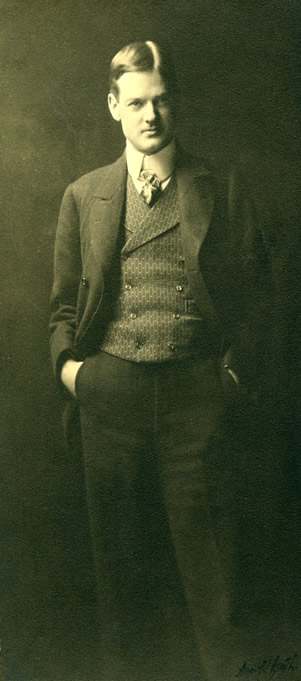The following story is courtesy of Finn J.D. John - Offbeat Oregon
Local boy saves millions from starving, becomes president
Few people know it, but the most hated president of the 20th
Century saved more people from starving to death than anyone else in
the history of the world — ever.

Herbert C. Hoover in the mid-1890s, shortly after
he graduated from Stanford University. Many
Oregon residents would have recognized "Bert" in
this picture. Photo is from the Herbert Hoover
Presidential Library in West Branch, Iowa. (For a
larger image, click here.)
By Finn J.D. John — May 3, 2009
In the early days of the Great Depression, Herbert Hoover was
the guy everybody loved to hate. The country was spiralling into a
worsening economic disaster, and all he could seem to do was mumble
about "confidence."
As is the case with most such moments in history, there was a
substantial amount of unfairness in this. But lately, with the country
on uncertain economic grounds, his name has been coming up more and
more often.
The thing is, there are several things most people don't know
about Hoover. The first is that he actually grew up in the Willamette
Valley.
The second is that he is personally responsible for saving
hundreds of millions of people from starving to death. The man holds the
world record. In fact, he prevented somewhere between two and five
times more deaths than Adolf Hitler, Josef Stalin and Pol Pot caused —
together.
An orphan in a strange land
Hoover's Oregon years started in 1885, when he was 11 and a
freshly bereaved orphan. Both his father and his mother died before they
were 40. His uncle, John Minthorn of Newberg, offered to take him in,
and so his relatives bundled him aboard a westbound train and sent him
to the Beaver State.
The future president was part of a strict Quaker community. As
such, as his biography from the Hoover Museum puts it, he was "put to
school and the chores." He milked the cow, split wood and cared for a
team of ponies on the Minthorn farm, while getting educated at Friends
Pacific Academy — which still exists, although it's a college now:
George Fox University.
When his uncle moved from Newberg to Salem and started the Oregon
Land Company, young Bert came with him, and served as an office
assistant there. His signature can still be seen on the title deed to
the Boston Mill, a historic gristmill on the Calapooia River near Shedd,
which is now a state park.
Hoover's time as an Oregonian came to an end after just six
years, when he moved to Palo Alto, Calif., to become a member of the
first class ever to graduate from Stanford University, where he met his
future wife, geology student Lou Henry. He never moved back to Oregon;
instead, he launched a career as a mining engineer, which took him all
over the world. In the early 1900s, he and his family actually circled
the world five times — this, of course, in a time when the best
vehicle on offer was a steamship.
Saving the children of Belgium
During World War I, Hoover engineered, launched and led a
program to get food to the starving people of occupied Belgium while
keeping it out of the hands of the German soldiers — if the Germans got
hold of it, the British Navy would cut off his access and the people
would starve. Faced with an alarming increase in glandular tuberculosis
brought on by malnutrition, his Committee for Relief in Belgium
actually invented a special cookie to feed the children there, to get
them proper nutrition in the most efficient way possible. This cookie
was made with "gray" wartime flour, cocoa powder and a little bit of
lard; to a well-fed Belgian child today, it would taste like lacquered
cardboard, but to that child's great-grandmother in 1917, it was
heavenly.
Feeding 300 million people
After the U.S. entered the war, Democratic President Woodrow
Wilson appointed Republican Hoover as the U.S.'s food administrator,
and after the war tapped him to figure out how to feed the starving
people of the rest of war-ravaged Europe. The American Relief
Administration quickly became the primary source of food for 300
million people in Europe.
How many of those people would have starved without Hoover's
expertise? How many Belgian children would have wasted away and died
without his cookies? The number cannot possibly be less than 200
million souls. It's probably much more than that. In his memoirs,
Hoover himself put the number at 1.4 billion, which, although certainly
on the high side, may actually be accurate; he was including lives saved
in the wake of World War II as well.
An ironic legacy
On a roster of world leaders who have been responsible, directly
or indirectly, for thousands or even millions of deaths, it's ironic
that one of the U.S. presidents to whom history has been the harshest
actually saved millions and millions of innocent people from a
miserable and agonizing death.
Hoover may not have handled the Depression as well as he could
have. But after learning the whole story of his life, it's hard to be
hard on him for that. And it's interesting to consider something else:
Would Hoover have learned what he needed to know if he had not grown up
in Newberg, not gone to George Fox and Stanford — if he had stayed in
Iowa at his father's blacksmith shop?
Maybe not.
His stony, uncaring reputation to the contrary, Herbert Hoover is a former Oregonian our state can be proud to claim.
Personal note:
I initially wrote this column after I had just discovered the
untold Herbert Hoover story. I posted it to the Internet and forgot
about it until 2012. The original contained a couple factual errors,
introduced by the source I was working with; in the years since then,
I've found an awful lot of source materials about Hoover are factually
inaccurate. Put simply, the man was a powerful political symbol, and
historical coverage tends to be informed largely by whether the author
approves or disapproves of what Hoover has come to represent — which,
ironically, is something considerably different from what he actually
endorsed.
If your interest has been piqued and you'd like to find out
more, I can enthusiastically recommend Martin Fausold, David Hinshaw and
Lee Nash. Hoover's own memoirs are also surprisingly fun to read,
although not always entirely accurate. If you're up for a more scholarly
treatment, Joan Hoff Wilson and George Nash are excellent. Should you
run across William Leuchtenburg's slim 2009 biographical sketch — can I
just tell you that I hate it? It's overtly and shamelessly hostile, is
sketchily and unprofessionally sourced, and reads like a political hit
piece. I have trouble believing a legitimate scholar is responsible for
it, because it is really not a work of scholarship, although it purports
to be one. Along the same lines, I suggest not bothering with any of
the dozens of "Presidential Series" books which you'll find in the usual
places in middle-school libraries and places like that. You'll find in
them the opposite problem from that posed by Leuchtenburg — that is,
most are fawning and uncritical, and pass on disputed anecdotes as
proven facts.
Finally, I should mention that I am now working on my second
book, and it's about Hoover's operations in Belgium. I probably will
hold off publishing it, though, until 2014, in the 100-year anniversary
year of the outbreak of the First World War.
(Sources: Hoover Presidential Library and Museum at
http://hoover.archives.gov; Hoover, Herbert.
The Memoirs of Herbert Hoover: Years of Adventure, 1874-1920. New York: MacMillan, 1951; Nash, George.
The Life of Herbert Hoover: The Humanitarian, 1914-1917. New York: Norton, 1984)
Click here to read more of Finn J.D. John's "Offbeat Oregon History."



























